Global Smart Warehousing Market, By Offering, By Organization Size, By Application, By Technologies, By Industry Vertical, By Region & Segmental Insights Trends and Forecast, 2024 – 2034
- Industry: Semiconductors & Electronics
- Report ID: TNR-110-1214
- Number of Pages: 420
- Table/Charts : Yes
- July, 2024
- Base Year : 2024
- No. of Companies : 10+
- No. of Countries : 29
- Views : 10113
- Covid Impact Covered: Yes
- War Impact Covered: Yes
- Formats : PDF, Excel, PPT
Smart warehousing refers to the integration of advanced technologies, such as automation, IoT, AI, and data analytics, to optimize warehouse operations. This market is experiencing rapid growth due to increasing demands for efficient inventory management, real-time tracking, and faster order fulfillment. Smart warehouses utilize automated systems like AGVs and AMRs, alongside sophisticated software for warehouse management, enhancing operational efficiency and reducing labor costs. The market is further propelled by the rise of e-commerce, requiring swift and accurate logistics solutions. Companies are investing heavily in smart warehousing technologies to remain competitive, improve customer satisfaction, and meet the ever-growing expectations of consumers.
The adoption of AI and machine learning for predictive analytics and maintenance is on the rise, enabling better decision-making and resource optimization. IoT devices are increasingly being used for real-time tracking and inventory management, ensuring accuracy and efficiency. Another trend is the use of blockchain for enhancing transparency and security in supply chain operations. Opportunities abound in developing regions where e-commerce is rapidly expanding, presenting a substantial market for smart warehousing solutions. Additionally, the push for sustainability and green logistics is driving the adoption of energy-efficient technologies in warehouses. In Terms of Revenue, the Global Smart Warehousing Market was Worth US$ 22.7 Bn in 2023 and is Anticipated to Witness a CAGR of 13.9% During 2024 – 2034.

Growth Drivers in Smart Warehousing Market
Technological Advancements in Automation and Robotics
Automated guided vehicles (AGVs), autonomous mobile robots (AMRs), and robotic arms have revolutionized the warehousing industry by enhancing operational efficiency and reducing labor costs. These technologies enable precise inventory management, faster order fulfillment, and seamless integration with warehouse management systems (WMS). Furthermore, innovations in artificial intelligence (AI) and machine learning (ML) allow predictive maintenance and real-time data analytics, leading to improved decision-making and resource optimization. As businesses seek to streamline operations and meet increasing consumer demands, the adoption of advanced automation solutions in warehouses is expected to grow, propelling the smart warehousing market forward.
E-commerce Expansion and Demand for Efficient Logistics
As online shopping continues to rise, there is an increasing demand for efficient logistics and faster delivery times. Smart warehousing solutions, equipped with Internet of Things (IoT) devices, real-time tracking, and advanced data analytics, enable companies to manage inventory more effectively, optimize storage space, and ensure timely order fulfillment. Moreover, the need to handle large volumes of diverse products and accommodate fluctuating demand patterns has led e-commerce giants to invest heavily in smart warehousing technologies. This trend is anticipated to accelerate, driving significant growth in the smart warehousing market as companies strive to enhance customer satisfaction and gain a competitive edge.
Smart Warehousing Market Segmentation by offering, organization size, application, technologies, industry vertical, Region
Hardware segment by offering is set to dominate the smart warehousing market, commanding a substantial revenue share of 47.3% over the forecast period. This segment is expected to command a substantial revenue share of 47.3% over the forecast period. The growth is driven by the rising adoption of these advanced automation technologies, which significantly enhance operational efficiency, reduce labor costs, and improve inventory management. Businesses are increasingly investing in hardware solutions to streamline their warehouse operations and meet the escalating demands of the modern supply chain, thereby propelling the market forward.
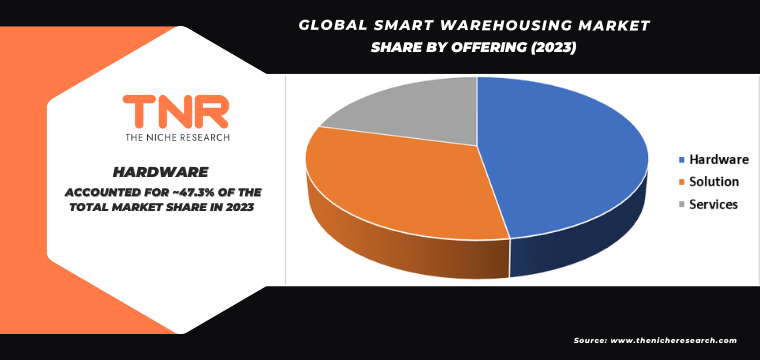
Large enterprises segment is anticipated to be the fastest-growing organization size in the smart warehousing market, capturing a substantial revenue share of 39.5% over the forecast period. This growth is driven by the substantial investments large enterprises are making in advanced warehousing technologies to enhance operational efficiency, reduce costs, and improve supply chain management. These companies are increasingly adopting automation, IoT, and AI-driven solutions to handle vast inventories and complex logistics requirements. The scale and resources of large enterprises enable them to implement comprehensive smart warehousing systems, ensuring they stay competitive and meet the evolving demands of their customers.
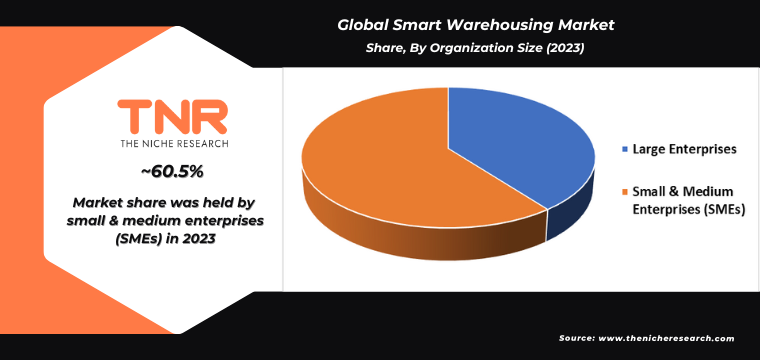
Warehouse management segment dominated the smart warehousing market, capturing a significant revenue share of 18.6% over the forecast period. This segment’s prominence is attributed to the growing need for efficient inventory control, real-time tracking, and streamlined logistics operations. Advanced warehouse management systems (WMS) offer robust solutions for optimizing storage, enhancing order accuracy, and improving overall operational efficiency. Businesses are increasingly adopting these systems to stay competitive and meet customer expectations for rapid and reliable service. The integration of WMS with other smart technologies further drives its adoption, solidifying its market leadership.
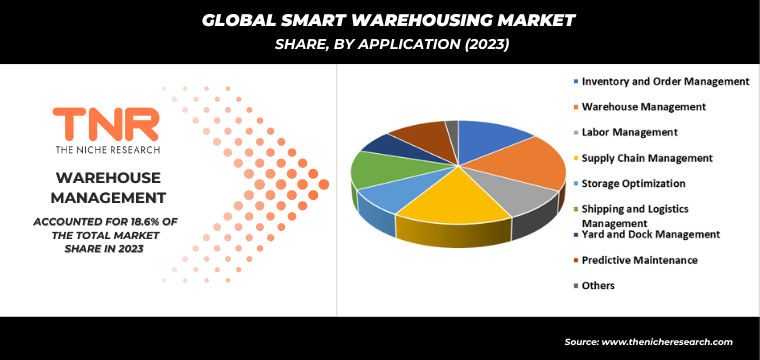
By technology, internet of things (IoT) are anticipated to grow fastest over the forecast timeline, capturing a revenue share of 19.2% in 2023. IoT technology enhances warehouse operations through real-time monitoring, automated inventory management, and improved asset tracking. These capabilities lead to increased efficiency, reduced operational costs, and better decision-making. The rapid adoption of IoT devices in warehouses enables seamless integration with other advanced technologies, providing businesses with comprehensive and dynamic solutions for their logistics needs. This surge in IoT implementation underscores its critical role in transforming and optimizing the warehousing industry.
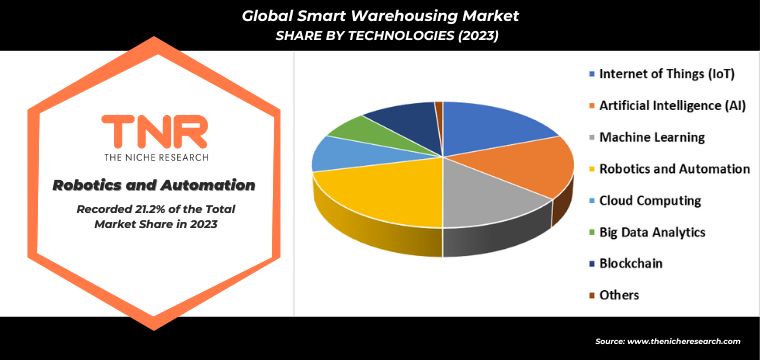
Logistics and transportation segment by industry vertical, dominated the smart warehousing market, accounting for a significant revenue share of 17.7% in 2023. This dominance is driven by the increasing demand for efficient and streamlined supply chain operations. Smart warehousing solutions in logistics and transportation enhance the management of goods, improve route optimization, and ensure timely deliveries. The integration of advanced technologies like automation, IoT, and AI in this sector leads to better inventory control, reduced operational costs, and higher customer satisfaction. As global trade and e-commerce continue to grow, the reliance on smart warehousing solutions in logistics and transportation is set to increase.
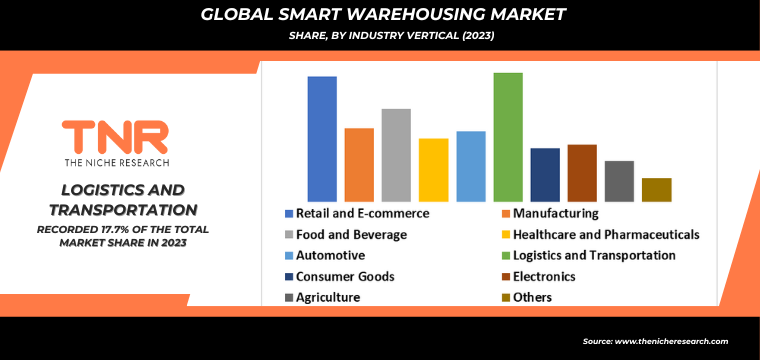
In 2023, Europe is anticipated to play a significant role in propelling the growth of the smart warehousing market, contributing approximately 20.8% to its overall expansion. This robust growth is fueled by the region’s rapid adoption of advanced technologies such as automation, IoT, and AI in warehouse operations. European businesses are increasingly investing in smart warehousing solutions to enhance operational efficiency, reduce costs, and meet stringent regulatory requirements. Additionally, the growth of e-commerce and the need for efficient logistics and supply chain management further support this trend. Europe’s commitment to innovation and technological advancements positions it as a key player in the global smart warehousing market.
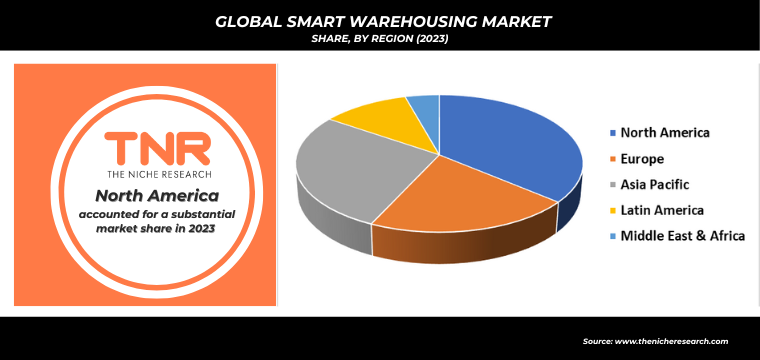
Key Developments
- In November 2023, Tecsys Inc. launched Elite WMS for Healthcare Distribution, a warehouse management system tailored to ensure efficient compliance with U.S. Food and Drug Administration (FDA) regulations, specifically those mandated by the Drug Supply Chain Security Act (DSCSA).
- In January 2022, HAI ROBOTICS entered into a strategic alliance with Voyatzoglou Systems, Greece’s leading intralogistics provider, to deliver smart warehousing solutions across Greece and the Balkan region.
Major Players in Smart Warehousing Market
- ABB Ltd.
- Cognex Corporation
- Honeywell International Inc.
- IBM Corporation
- KION Group AG
- Manhattan Associates
- Oracle Corporation
- PSI Logistics
- Reply
- SAP SE
- Siemens
- Tecsys, Inc.
- Zebra Technologies Corporation
- Other Industry Participants
Global Smart Warehousing Market Scope
| Report Specifications | Details |
| Market Revenue in 2023 | US$ 22.7 Bn |
| Market Size Forecast by 2034 | US$ 94.8 Bn |
| Growth Rate (CAGR) | 13.9% |
| Historic Data | 2016 – 2022 |
| Base Year for Estimation | 2023 |
| Forecast Period | 2024 – 2034 |
| Report Inclusions | Market Size & Estimates, Market Dynamics, Competitive Scenario, Trends, Growth Factors, Market Determinants, Key Investment Segmentation, Product/Service/Solutions Benchmarking |
| Segments Covered | By Offering, By Organization Size, By Application, By Technologies, By Industry Vertical, By Region |
| Regions Covered | North America, Europe, Asia Pacific, Middle East & Africa, Latin America |
| Countries Covered | U.S., Canada, Mexico, Rest of North America, France, The UK, Spain, Germany, Italy, Nordic Countries (Denmark, Finland, Iceland, Sweden, Norway), Benelux Union (Belgium, The Netherlands, Luxembourg), Rest of Europe, China, Japan, India, New Zealand, Australia, South Korea, Southeast Asia (Indonesia, Thailand, Malaysia, Singapore, Rest of Southeast Asia), Rest of Asia Pacific, Saudi Arabia, UAE, Egypt, Kuwait, South Africa, Rest of Middle East & Africa, Brazil, Argentina, Rest of Latin America |
| Key Players | ABB Ltd., Cognex Corporation, Honeywell International Inc., IBM Corporation, KION Group AG, Manhattan Associates, Oracle Corporation, PSI Logistics, Reply, SAP SE, Siemens, Tecsys, Inc., Zebra Technologies Corporation |
| Customization Scope | Customization allows for the inclusion/modification of content pertaining to geographical regions, countries, and specific market segments. |
| Pricing & Procurement Options | Explore purchase options tailored to your specific research requirements |
| Contact Details | Consult With Our Expert
Japan (Toll-Free): +81 663-386-8111 South Korea (Toll-Free): +82-808- 703-126 Saudi Arabia (Toll-Free): +966 800-850-1643 United Kingdom: +44 753-710-5080 United States: +1 302-232-5106 E-mail: askanexpert@thenicheresearch.com
|
Global Smart Warehousing Market
By Offering
- Hardware
- Sensors
- RFID Tags
- Automated Picking Tools
- Automated Guided Vehicles (AGVs)
- Others
- Solution
- Services
- Consulting
- Implementation and Integration
- Maintenance and Support
- Others
By Organization Size
- Large Enterprises
- Small & Medium Enterprises (SMEs)
By Application
- Inventory and Order Management
- Warehouse Management
- Labor Management
- Supply Chain Management
- Storage Optimization
- Shipping and Logistics Management
- Yard and Dock Management
- Predictive Maintenance
- Others
By Technologies
- Internet of Things (IoT)
- Artificial Intelligence (AI)
- Machine Learning
- Robotics and Automation
- Cloud Computing
- Big Data Analytics
- Blockchain
- Others
By Industry Vertical
- Retail and E-commerce
- Manufacturing
- Food and Beverage
- Healthcare and Pharmaceuticals
- Automotive
- Logistics and Transportation
- Consumer Goods
- Electronics
- Agriculture
- Others
By Region
- North America (U.S., Canada, Mexico, Rest of North America)
- Europe (France, The UK, Spain, Germany, Italy, Nordic Countries (Denmark, Finland, Iceland, Sweden, Norway), Benelux Union (Belgium, The Netherlands, Luxembourg), Rest of Europe)
- Asia Pacific (China, Japan, India, New Zealand, Australia, South Korea, Southeast Asia (Indonesia, Thailand, Malaysia, Singapore, Rest of Southeast Asia), Rest of Asia Pacific)
- Middle East & Africa (Saudi Arabia, UAE, Egypt, Kuwait, South Africa, Rest of Middle East & Africa)
- Latin America (Brazil, Argentina, Rest of Latin America)
Report Layout:
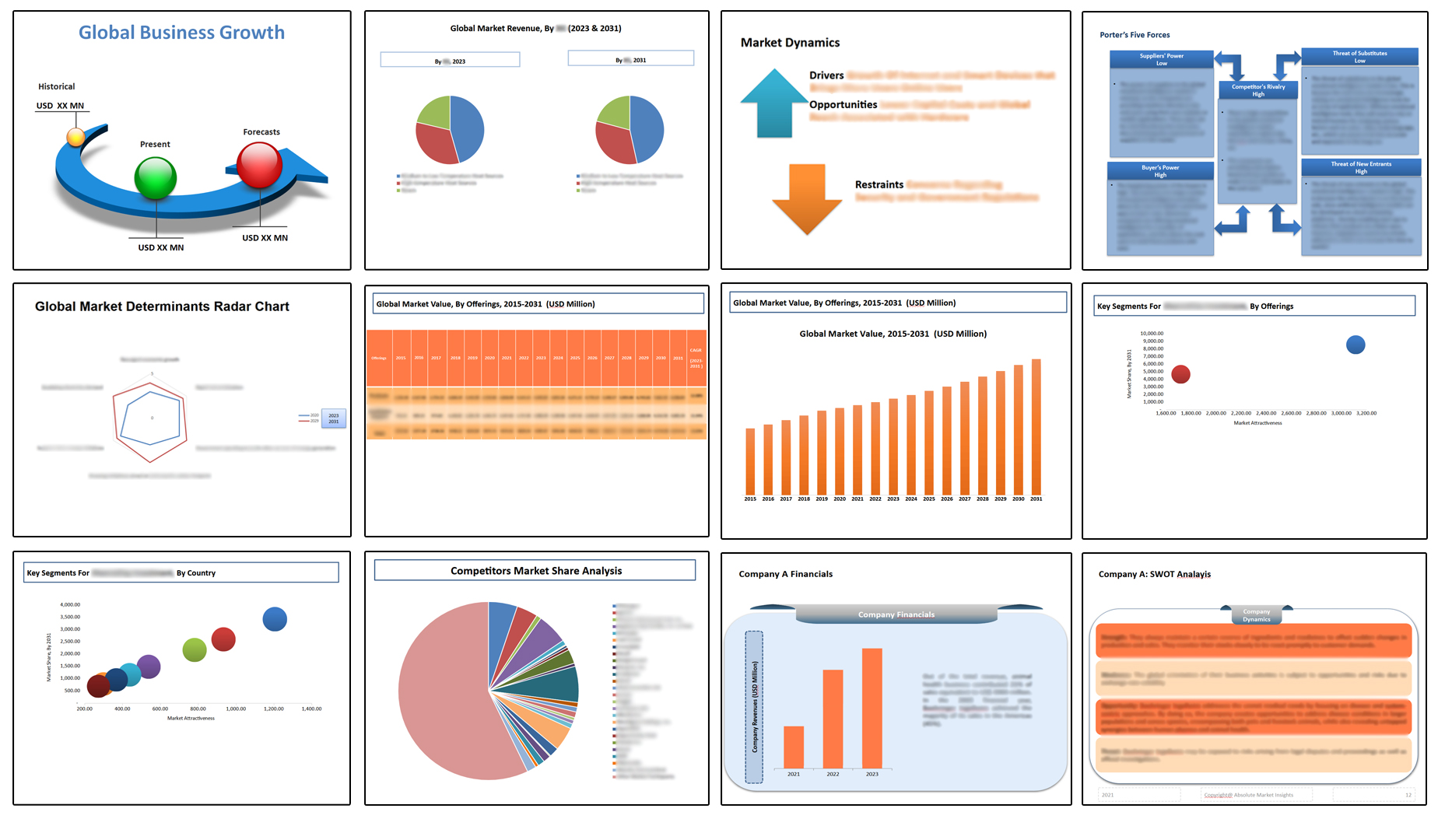
Table of Contents
Global Smart Warehousing Market
By Offering
- Hardware
- Sensors
- RFID Tags
- Automated Picking Tools
- Automated Guided Vehicles (AGVs)
- Others
- Solution
- Services
- Consulting
- Implementation and Integration
- Maintenance and Support
- Others
By Organization Size
- Large Enterprises
- Small & Medium Enterprises (SMEs)
By Application
- Inventory and Order Management
- Warehouse Management
- Labor Management
- Supply Chain Management
- Storage Optimization
- Shipping and Logistics Management
- Yard and Dock Management
- Predictive Maintenance
- Others
By Technologies
- Internet of Things (IoT)
- Artificial Intelligence (AI)
- Machine Learning
- Robotics and Automation
- Cloud Computing
- Big Data Analytics
- Blockchain
- Others
By Industry Vertical
- Retail and E-commerce
- Manufacturing
- Food and Beverage
- Healthcare and Pharmaceuticals
- Automotive
- Logistics and Transportation
- Consumer Goods
- Electronics
- Agriculture
- Others
By Region
- North America (U.S., Canada, Mexico, Rest of North America)
- Europe (France, The UK, Spain, Germany, Italy, Nordic Countries (Denmark, Finland, Iceland, Sweden, Norway), Benelux Union (Belgium, The Netherlands, Luxembourg), Rest of Europe)
- Asia Pacific (China, Japan, India, New Zealand, Australia, South Korea, Southeast Asia (Indonesia, Thailand, Malaysia, Singapore, Rest of Southeast Asia), Rest of Asia Pacific)
- Middle East & Africa (Saudi Arabia, UAE, Egypt, Kuwait, South Africa, Rest of Middle East & Africa)
- Latin America (Brazil, Argentina, Rest of Latin America)
The Niche Research approach encompasses both primary and secondary research methods to provide comprehensive insights. While primary research is the cornerstone of our studies, we also incorporate secondary research sources such as company annual reports, premium industry databases, press releases, industry journals, and white papers.
Within our primary research, we actively engage with various industry stakeholders, conducting paid interviews and surveys. Our meticulous analysis extends to every market participant in major countries, allowing us to thoroughly examine their portfolios, calculate market shares, and segment revenues.
Our data collection primarily focuses on individual countries within our research scope, enabling us to estimate regional market sizes. Typically, we employ a bottom-up approach, meticulously tracking trends in different countries. We analyze growth drivers, constraints, technological innovations, and opportunities for each country, ultimately arriving at regional figures.Our process begins by examining the growth prospects of each country. Building upon these insights, we project growth and trends for the entire region. Finally, we utilize our proprietary model to refine estimations and forecasts.
Our data validation standards are integral to ensuring the reliability and accuracy of our research findings. Here’s a breakdown of our data validation processes and the stakeholders we engage with during our primary research:
- Supply Side Analysis: We initiate a supply side analysis by directly contacting market participants, through telephonic interviews and questionnaires containing both open-ended and close-ended questions. We gather information on their portfolios, segment revenues, developments, and growth strategies.
- Demand Side Analysis: To gain insights into adoption trends and consumer preferences, we reach out to target customers and users (non-vendors). This information forms a vital part of the qualitative analysis section of our reports, covering market dynamics, adoption trends, consumer behavior, spending patterns, and other related aspects.
- Consultant Insights: We tap into the expertise of our partner consultants from around the world to obtain their unique viewpoints and perspectives. Their insights contribute to a well-rounded understanding of the markets under investigation.
- In-House Validation: To ensure data accuracy and reliability, we conduct cross-validation of data points and information through our in-house team of consultants and utilize advanced data modeling tools for thorough verification.
The forecasts we provide are based on a comprehensive assessment of various factors, including:
- Market Trends and Past Performance (Last Five Years): We accurately analyze market trends and performance data from preceding five years to identify historical patterns and understand the market’s evolution.
- Historical Performance and Growth of Market Participants: We assess the historical performance and growth trajectories of key market participants. This analysis provides insights into the competitive landscape and individual company strategies.
- Market Determinants Impact Analysis (Next Eight Years): We conduct a rigorous analysis of the factors that are projected to influence the market over the next eight years. This includes assessing both internal and external determinants that can shape market dynamics.
- Drivers and Challenges for the Forecast Period:Identify the factors expected to drive market growth during the forecast period, as well as the challenges that the industry may face. This analysis aids in deriving an accurate growth rate projection.
- New Acquisitions, Collaborations, or Partnerships: We keep a close watch on any new acquisitions, collaborations, or partnerships within the industry. These developments can have a significant impact on market dynamics and competitiveness.
- Macro and Micro Factors Analysis:A thorough examination of both macro-level factors (e.g., economic trends, regulatory changes) and micro-level factors (e.g., technological advancements, consumer preferences) that may influence the market during the forecast period.
- End-User Sentiment Analysis: To understand the market from the end-user perspective, we conduct sentiment analysis. This involves assessing the sentiment, preferences, and feedback of the end-users, which can provide valuable insights into market trends.
- Perspective of Primary Participants: Insights gathered directly from primary research participants play a crucial role in shaping our forecasts. Their perspectives and experiences provide valuable qualitative data.
- Year-on-Year Growth Trend: We utilize a year-on-year growth trend based on historical market growth and expected future trends. This helps in formulating our growth projections, aligning them with the market’s historical performance.
Research process adopted by TNR involves multiple stages, including data collection, validation, quality checks, and presentation. It’s crucial that the data and information we provide add value to your existing market understanding and expertise. We have also established partnerships with business consulting, research, and survey organizations across regions and globally to collaborate on regional analysis and data validation, ensuring the highest level of accuracy and reliability in our reports.








